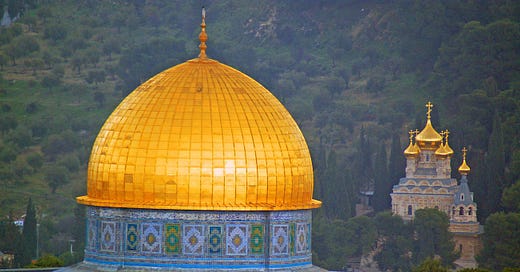The Church will Survive (Thrive?) the Election
The Church has lived and thrived in most every imaginable situation for thousands of years. This year's political cycle is no big deal.
Americans get particularly anxious about elections. ‘Four more years’ is a funny chant, as if that is the time frame that matters. Looking back on church history and the people of God more generally, they have survived and thrived in every conceivable environment. While history is inevitably written by the powerful and the victors, mundane, small, minority communities have also shaped Christianity. The Kingdom of God expands in upside down and left-handed ways as yeast, seeds and small things.
Under 1st Century Roman Rule the church grew exponentially, though a small minority thought by the broader population to be a cult. The government ruled with a militaristic iron fist and the religion of the day was polytheistic. Public holidays, rituals and entertainment centered on worship of various deities. Christians lived differently and took lots of flak for valuing monogamy between a man and a woman, caring for the poor, even outsiders, sharing possessions and meals with people of all classes and caring for vulnerable infants.
During the Persian theocratic Rule in the 6-8th centuries and the economic and military power expansion of the Islamic caliphates, the Church of the East established theological schools and followed trade routes, evangelizing the Eastern world, eventually to China. The Church of the East pre-dated Islam by hundreds of years and was a missionary force in the region expanding through Turkey and to the East. Though a minority, they persevered through harsh conditions, served in imperial courts and translated important manuscripts.
During the Islamic conquests of the 7-19th century up through the Ottoman age which concluded at the end of WWI, Christians lived in the Middle East as dhimmi minority communities. They also served in official roles, lived in villages and cities, and there are stories of conversion among Muslims to Christianity even in this very sectarian power-imbalance. The church today in the Levant and North Africa traces its roots to this church that persevered during an Islamic theocracy. Ironically when the Western world started to send missionaries to the Middle East and North Africa in the 18-19th centuries, they found a church, imperfect, somewhat isolated, but present and rooted in the land and cultures of the region.
The church survived through the Christendom era of various monarchies from Constantine through the Crusades of the 11-16th centuries. Benedictine (6th) and Franciscan (12th) monastic movements challenged power-hungry church leaders. Reformers like Raymond Lull and St. Francis kept the faith alive and visibly present in embodied alternative communities. Francis left his life of privilege and eschewed military service giving it all up to love the poor, live a life of radical generosity. He also challenged the Crusading mentality, crossing battle lines at risk of death to meet personally with the Sultan of Egypt and earned a hearing, presenting the good news instead of fighting Muslim armies. During the Reformation numerous courageous believers challenged the status quo of church corruption and entanglement with power politics insisting that salvation was by grace through faith.
During communism there are numerous examples from the USSR, Kyrgyzstan and Ukraine of churches that lived humbly, preached boldly and suffered for the gospel. Their examples and witness resulted in amazing growth in the 1990’s when the iron curtain lifted, with over 20,000 believers counted in Kyrgystan alone in the decade following.
Christians survived and were witnesses in autocracies like the Russian Empire and Nazi Germany, through dictatorships and genocide in places like Sudan, Rwanda, and South Africa and stand as witnesses today in tough Islamic monarchies, failed states and in the midst of polarizing conflicts like Israel/Palestine and Lebanon.
This brief recitation of some history illustrates that the church is not threatened by geo-political affairs, types of governments, migration or by the next election. It has survived every conceivable style of politic and form of government (or non-government). Even in the worst case scenarios… let’s say war, mass migration and ethnic cleansing (like Sudan or Rwanda)… the church has been shaped for the better by the movement of Christians outward, taking their faith with them as they go. As Jehu Hanciles has demonstrated, the church has grown and spread primarily through migration and people movement. He says:
migration has been an indispensable element in the advancement of the Christian faith from the earliest beginnings and a prime factor in the plural frontiers of cross-cultural engagement that mark the world Christian movement… every Christian migrant is a potential missionary1.
Hanciles notes that ‘empire’ is usually the central model for thinking about history, but there are other, perhaps even more influential actors. The marginalized, the poor, the migrants, the dispossessed and battered. These disempowered groups have agency and influence that, while not garnering as much attention in the history books, is deeply influential. The church is still present after 2000 years, it has found a home in nearly ever culture, language, political structure and geography on earth. It survives and thrives in poverty, riches, turmoil and peace. The Roman Empire fell along with the Ottoman, the USSR and so many dictators, but the church persists.
These dynamics historically help put into perspective our current political hot topics like elections and immigration. While certainly a nuanced and complicated matter, from a church perspective, when people move, they take their faith with them and plant, enrich, challenge and renew it. The next election cycle seems like an apocalyptic crisis if you listen to the politicians, but for you, Christian, take comfort, the church will survive and the Kingdom of God will come.
Hanciles, Jehu J. Migration and the Making of Global Christianity. Grand Rapids, MI: Wm. B. Eerdmans Publishing Co., 2021.




